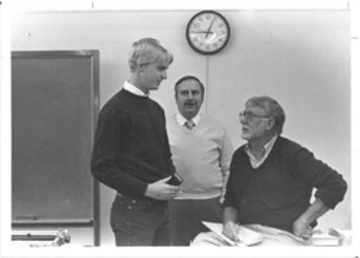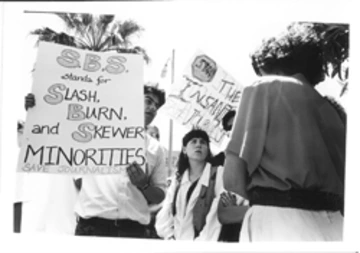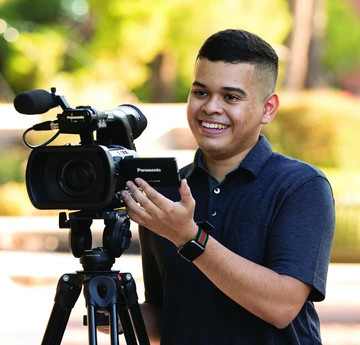For seven decades, the University of Arizona's journalism programs have been preparing students to cover complex events and issues wherever they occur—locally, nationally, or internationally. In the school's state-of-the-art computer laboratories, broadcast and podcast studios, as well as seminar rooms, students not only develop and refine their journalistic skills but also work on stories that are published in real-world news media. Alongside this hands-on experience, they engage in critical study of the political, economic, legal, and ethical challenges journalists face in today's global information age, ensuring they are equipped to navigate the rapidly evolving media landscape with integrity and insight.
Department Roots

Former journalism student Steve Elliott (left) receives his pen in the Mark Finley Newswriting Competition from Professors Bick Lewis (center) and Phil Mangelsdorf.
The School of Journalism — originally known as the Department of Journalism — officially began operations in January 1951, with Douglas D. Martin serving as its first head. Prior to achieving departmental status, journalism courses were part of the Department of English curriculum. The faculty members who led the program were seasoned journalists themselves before transitioning into academia, bringing real-world experience into the classroom. Douglas Martin, a Pulitzer Prize winner with the Detroit Free Press, set the foundation for the department’s success.
In 1964, the department received accreditation for the first time, a distinction it has maintained ever since, ensuring that it meets the highest national standards for teaching, research, and service. Today, the University of Arizona's journalism program is one of just 109 accredited programs in the United States and one of only two accredited programs in the state, underscoring its longstanding commitment to excellence in preparing the next generation of journalists.
Community Journalism
The department significantly expanded its curriculum in the 1970s when it established a professional master’s degree program and started several real-world news media. Donald W. Carson started the department’s Community News Service in 1973, enabling students to cover statewide stories for small news outlets — a practice that continued as Arizona Sonora News.
Mangelsdorf and George Ridge, the program’s fifth head, were responsible for bringing the historic Tombstone Epitaph to the UA in 1975, giving students the chance to publish a real community newspaper. A year later, Jacqueline E. Sharkey founded El Independiente, the only bilingual newspaper in the country produced by journalism students for a real community on a regular basis. In 2012, the publication moved from a newspaper to a magazine format and shortened the name to El Inde in late 2019. Recently, the publication has moved to a digital platform as a webzine or e-zine.
El Independiente is one indication of the program's longstanding commitment to diversity. Another came in 2010 when the program was presented with the Robert P. Knight Multiculturalism Award at the AEJMC convention.
Changes in classroom technology mirrored the changes in the journalism industry. The hum from video display terminals replaced the banging of typewriter keys in 1971, and by the mid-1980s, students working on the school’s community newspapers reveled in the new last typesetting system. In 1979, the department moved into new quarters in the renovated basement of the Selim Franklin Building, which provided more space for instructional laboratories.
In 2023, the School of Journalism took a major step forward with the launch of its first Broadcast-Podcast Studio. This cutting-edge facility is designed to provide students with hands-on experience in a professional media environment. Equipped with state-of-the-art technology found in many top-tier newsrooms, the studio includes studio cameras, monitors, switchboards, lighting units, podcast-friendly microphones, and a master control room. This new resource empowers students to create high-quality broadcast and podcast content while developing the technical skills necessary for success in today’s fast-evolving media landscape.
Closure Threat

Students protest the proposed elimination of the journalism program, 1994-96.
The program encountered its biggest challenge in 1994-96, when university administrators threatened it with closure. The number of faculty and students declined during those years. The threat passed, thanks to more than 1,000 students, alumni, news executives and community leaders who defended the program. The department began to rebuild, but losses were suffered due to the months-long battle. Student enrollment dropped to a low of about 180 undergraduates. A university-wide hiring freeze compounded by a spate of retirements took the faculty size to just four full-timers at its lowest point.
Faculty suspended admission to the graduate program to be able to serve the undergraduate students and to create a new graduate curriculum. Student enrollment climbed and new faculty were hired.
In 2004, the program moved into the $17 million Louise Foucar Marshall Building, a space complete with classrooms and labs capable of handling the future needs of a department full of teaching and research faculty, plus hundreds of students working in print, television and digital media.
Growth and Change
After this, enrollment grew to more than 500 undergraduates, with 16 permanent faculty members and nearly a dozen part-time faculty. The faculty included the leader of a Pulitzer Prize-winning investigation, a New York Times bestselling author, the former chief international correspondent for The Associated Press, and the winner of top awards from Investigative Reporters and Editors and the Society of Professional Journalists for international reporting.
Two faculty members named national Journalism Teacher of the Year, an award sponsored by the Association for Education in Journalism and Mass Communication. It is the most prestigious award in journalism education.
The graduate program welcomed its first class back in 2008, offering the master of arts in journalism as well as dual degrees with five other programs on campus. That same year the department became the School of Journalism.

Broadcast student Hector Ponce
Photo by Simon Asher
In Spring 2021, the school launched an online Studies on Global Media program with the support of the University Arizona Online. The program offers 20 courses at the undergraduate level that build out specialty areas for students in the school. The School of Journalism received more than $160,000 in support eight faculty who, with university technology support, built 20 courses online for 7 1/2-week semesters. Specialties include major areas and issues of our time: Entrepreneurial Media, Innovation and Sustainability; Media and Human Rights; Media, Science and the Environment; Media and Crises; Disinformation, Misinformation, Information Rights and Digital Security; and Media, Social Justice and Engagement. The courses are offered six times a year (every summer) in 7 1/2-week semesters.
In Fall 2021, we launched the Bilingual Journalism M.A., a a cutting-edge program that offers professional and academic training for students who want to report about and/or for Latinx communities in the United States and abroad. It is one of the only fully bilingual programs in the country. Graduates will acquire a robust set of skills in both Spanish and English that will translate into a significant competitive edge in the workplace.
Currently, the school offers innovative interdisciplinary programs that enable undergraduate and graduate students to focus on areas of crucial importance: international journalism, science journalism, border and global journalism, and bilingual journalism. Classes are taught by faculty with extensive professional and academic experience in these fields.
The school also is a leader in border journalism, developing courses and workshops that have become models for other programs, and forging relationships among educators and journalists in the United States and Mexico.
Another reflection of the quality education provided by the program is the fact that The New York Times has selected the school as the exclusive site for the national student journalism workshop that was offered in partnership with the National Association of Hispanic Journalists.
Today, as the school looks back on its founding in 1951 and forward to another 70 years, it can do so knowing that students are getting the education and training they need to succeed in an ever-changing media environment. UA Journalism graduates have gone to work for major news media ranging from The New York Times to CNN International, have won every major award in the profession — including the Pulitzer Prize and the National Magazine Award — and have written stories that have changed state and national laws and policies.

